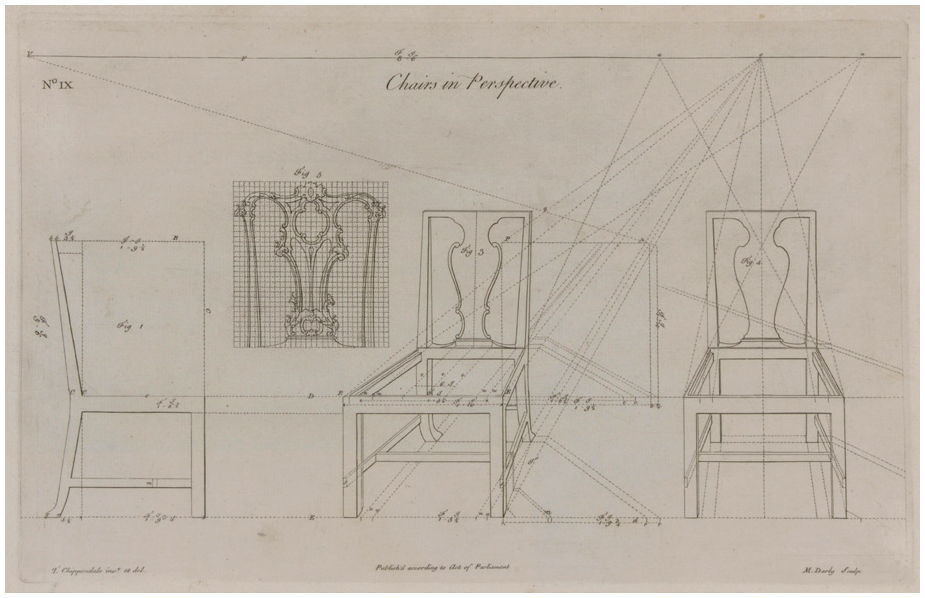Beauty, Craftsmanship and Design
The furnishings created by Thomas Chippendale, Sr. (1718-1799) and the company he founded in 1750s London are prized around the world. The works have proven so popular that their distinct style, and the pieces patterned after the originals, were honored with a school named after the designer. The appellation “Chippendale” also represents the first time a philosophy of design was named after the artist, rather than the monarch under which he served.
Chippendale furniture was constructed widely from sturdy, beautiful woods – mahogany from the East Indies, and maple, walnut and cherry from English and European forests. While he sometimes used veneers for decorative sections, weight bearing elements were typically made from single pieces of wood. Decoratively, he used elements that spanned the then-known world and he made into his own unique style.
Thomas Chippendale came from an extended family of wood workers. Working by hand, they used saws, chisels, gimlets and planes to shape desks, chairs, beds and more. The craft was passed from generation to generation as apprentices became journeymen, then masters of the profession. The family also shared and passed forward the knowledge each generation learned.
Chippendale helped evolve the craft of furniture into a formal field of academic study, and made inroads into self-promotion and marketing, with the publication of his book, “The Gentleman and Cabinet-Maker’s Director” in 1754. The work’s shortened subtitle was “A Large Collection of the most Elegant and Useful Designs of Houshold (sic.) Furniture in the Gothic, Chinese and Modern Taste.”
The subtitle continues: “Including a great Variety of Book-Cases for Libraries or Private Rooms, Commodes, Library and Writing-Tables, Buroes (sic), Breakfast-tables, Dressing and China-Tables, China-Cases, Hanging-Shelves, Tea-Chests, Trays, Fire-Screens, Chairs, Settees, Sopha’s (sic.), Beds, Presses and Cloaths-Chests, Pier-Glass Sconces, Slab Frames, Brackets, Candle-Stands, Clock-Cases, Frets, and Other Ornaments to Which Is Prefixed, A Short Explanation of the Five Orders of Architecture, and Rules of Perspective; with Proper Directions for executing the most difficult Pieces, the Mouldings being exhibited at large, and the Dimensions of each Design specified: The Whole Comprehended in One Hundred and Sixty Copper-Plates, neatly Engraved, Calculated to improve and refine the present Taste, and suited to the Fancy and Circumstances of Persons in all Degrees of Life.”
The book was a best seller, supported before publication by more than 300 individuals — gentleman, aristocrats and fellow craftsmen. It was reprinted in 1755 and a revised and expanded edition was published in 1762.
Megan Mulder, special collections librarian, Wake Forest University, wrote: “…fashionable London was a competitive market, and Chippendale needed a way to distinguish himself from the crowd. He hit upon the idea of publishing what was essentially a deluxe catalog of his designs. It was titled The Gentleman and Cabinetmaker’s Director. A few English furniture makers had published their designs before, but nothing had come close to the scale of Chippendale’s large folio volume.”
The work was successful in helping establish the Chippendale brand. While the book may have served to improve sales in England, Europe and the emerging markets of North America, it did not achieve the goal of earning its author a Royal Commission. No problem for history, though. The name “Chippendale” today is synonymous with craftsmanship of the highest quality.
The Gentleman and Cabinetmaker’s Director also contains the author’s professional armamentarium, including principles of design and perspective. The work details the qualities distinguishing the five primary styles of his day, as well as shares patterns for cutting, lathing and shaping varieties of wood.
By writing and publishing what he knew, Chippendale helped pass to those in the future the hallmarks of his artistry. That itself is the sign of cultural progress – sharing with the world one’s understanding. That appreciation for the arts and sciences not only advances our quality of life, it supports our civilization.

